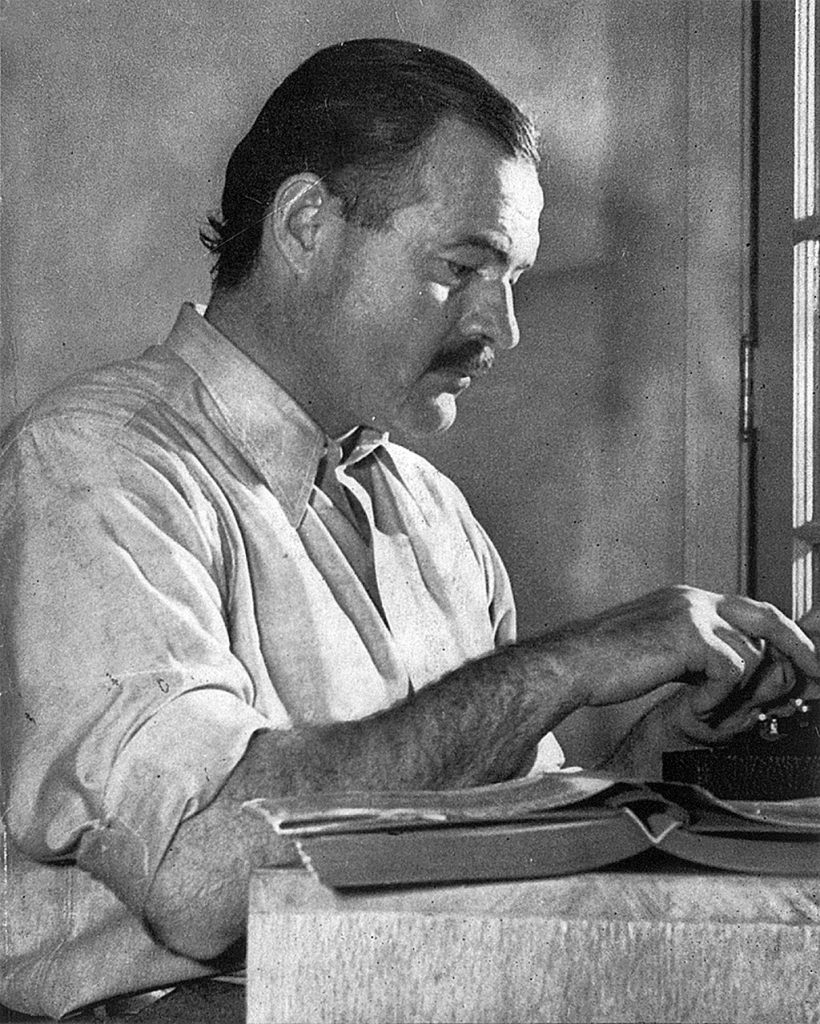73 Ernest Hemingway (1899 – 1961)
Amy Berke; Robert Bleil; Jordan Cofer; and Doug Davis

Ernest Hemingway was born and raised in Oak Park, Illinois, an affluent suburb of Chicago. His father, who was prone to depression and would later commit suicide, was a physician and his mother was a singer turned music teacher. Because Hemingway’s father was an avid outdoorsman, the family spent many of their summers in northern Michigan, which is where Hemingway set many of his short fiction, including the Nick Adams stories.
In 1917, Hemingway, at that time a writer for The Kansas City Star, was eager to join the Armed Forces to fight in the Great War (World War I) but was medically disqualified. Undiscouraged, he joined the ambulance corps and served on the Italian front. During shelling, Hemingway received a shrapnel injury but still carried a comrade to safety and was decorated as a hero.
When Hemingway returned to the States, living ultimately in Chicago, he fell under the mentorship of fellow modernist, Sherwood Anderson, who encouraged Hemingway to move to Paris. In 1920, Hemingway married Hadley Richardson; soon afterwards, the couple left for Paris. Surrounded by other writers of the period, such as Gertrude Stein, F. Scott Fitzgerald, Ezra Pound, Hemingway used these connections to help develop his own writing career. With F. Scott Fitzgerald’s help, Hemingway published his first novel The Sun Also Rises (1926) to great acclaim. The novel established Hemingway’s simplistic writing style while expressing the frustration that many felt about World War I. His second novel, A Farewell to Arms (1929), another critical success, once again, captured the disillusionment of the modernist period.
While Hemingway had a turbulent personal life, filled with divorces and failed relationships, he continued to write successful works including several collections of short fiction, for which he was well known, as well as novels and non-fiction. Some of his many works are Death in the Afternoon (1932), bringing bullfighting to a larger audience; To Have and Have Not (1937); and For Whom the Bell Tolls (1940), a classic novel on the Spanish Civil War. In 1952, Hemingway wrote what many consider to be his finest work, Old Man and the Sea, which was awarded the PulitzerPrize and led to his Nobel Prize for Literature in 1954. In 1961, after struggling with depression for years, Ernest Hemingway took his own life in Ketchum, Idaho. In 1964, Scribners published his posthumous memoir, A Moveable Feast, which details both Hemingway and Hadley’s expatriate life in Paris during the modernist period.
Hemingway’s writing was well known stylistically for its short declarative sentences and lack of detail. Hemingway often said this style based on his iceberg approach to narrative, where, like an iceberg, ten percent of the story was on the surface and ninety percent was under the water. Hemingway attributes this style to his time spent as a journalist. Due to his distinctive style, Hemingway remained an immensely popular writer and his novels were not only critically acclaimed but also best sellers. In both “The Short Happy Life of Francis Macomber” and “The Snows of Kilimanjaro,” Hemingway writes about couples on safari in Africa and both stories feature couples with troubled relationships. These two stories are great examples of Hemingway’s technique since it is clear to the reader that the narrator is leaving out many details about the characters’ history.
“The Snows of Kilimanjaro”

Or click the link below to access this selection:
https://web.archive.org/web/20231017012617/http://xroads.virginia.edu/~DRBR/heming.html
“The Short, Happy Life of Francis Macomber”


